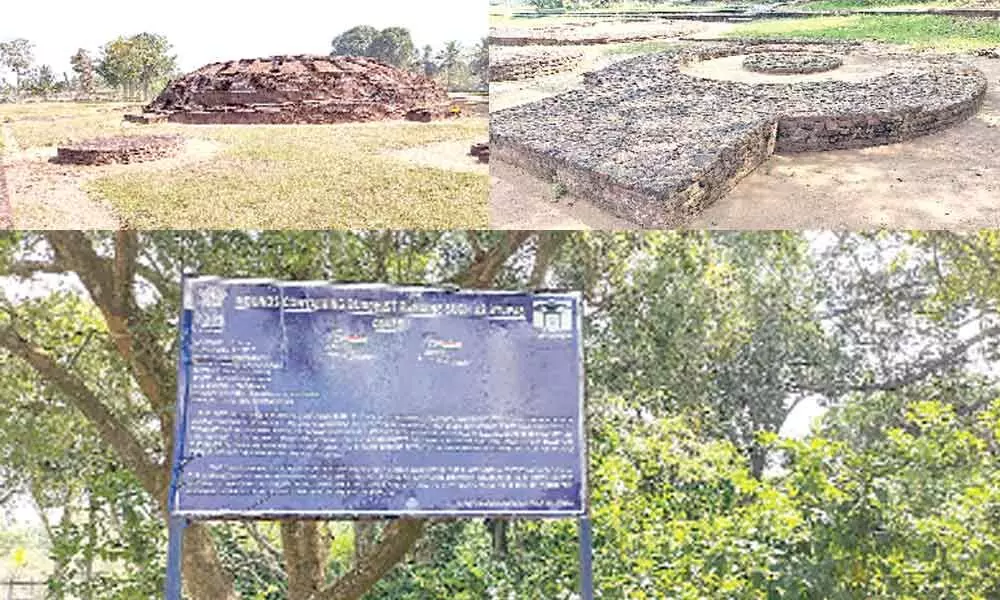Live
- Allu Arjun, Sreeleelaset the floor on firewith ‘Kissik’
- Tawi Riverfront project will expand Jammu division's tourism: J&K L-G
- Tamil Nadu Assembly session to begin on December 9
- Kerala CM Pinarayi Vijayan is a chameleon: LoP Satheesan
- ‘Vere Level Office’ trailer showcases a unique office sitcom
- Vivek-Mervin to make Tollywood debut with ‘RaPo22’
- Telangana Rejects Adani Foundation’s Rs.100 Crore CSR Grant for Young India Skills University
- Hebahstuns with timeless elegance
- Vijay Deverakonda's Rowdy Wear Shines as Iconic Indian Streetwear at Outlook India Business Awards 2024
- Manglishines bright with ‘Ustaad Bismillah Khan YuvaPuraskar’
Just In
Kakinada: Buddhist tourist spot in Konaseema needs uplift


It is surprising to find Buddhist lyrics in the far corner of Mamidikuduru mandal in East Godavari district in Konaseema.
Kakinada: It is surprising to find Buddhist lyrics in the far corner of Mamidikuduru mandal in East Godavari district in Konaseema. Adurru is a little-known place for the layman, but for an ardent devotee of Buddhism, it is sacred and quite interesting for his Buddhistic pursuit.
Adurru (or locally Dubaraju Dibba) is a 2,400-year-old Buddhist site located on the western bank of the Vainetaya, a tributary of River Godavari, which is around 9.5-km from the Bay of Bengal in Mamidikuduru mandal. The site was excavated by Archaeological Survey of India (ASI) in 1923 and declared as a protected monument in 1955.
According to sources, among the three most popular Buddhist stupas in the world, the first one was constructed in Adurru and the second one in Ranchi, Jharkhand; and the third one was in Sarnath, Bihar. According to historical evidence of ASI, foundation stone for Adurru was laid by Sanghamithra, a Buddhist nun and daughter of Emperor Ashoka. The material pertaining to Adurru is very scanty and doesn't throw much light on the activities of Buddhists in that area. It is also doubtful whether any evidence of their full-fledged existence has been destroyed by the adversaries of Buddhism.
As this Buddhist centre is home to the remains of stupas, several upa-stupas, chaityas and viharas, this is considered as 'Mahakshetram' by Buddhist monks and followers even today. In 1953, the ASI conducted excavations that brought to light the remains of stupas, chaityas and viharas.
The most beautiful and the most famous one is Mahastupa, built like a giant wheel with a platform with a diameter of 17 feet. In 1955, the ASI declared this a protected monument. The excavations also brought to light artefacts such as jars, troughs, dishes and bowls. On the front side, (on the east) are two upa-stupas with the same wheel-based structure. There are also round and square structures on the west side of the main stupam, all systematically connected with each other from all sides.
According to ASI officials, Adurru known as Dubaraju Gudi was subjected to vandalism particularly by local zamindar. The Buddhist remains cover an area of 3,200 square metre (around 2.04 acres) with a 4-m high mound.
Buddhists from places like Tibet, Himalayas, China make a pilgrimage to this revered spot and pay homage to Lord Buddha. They also used to offer prayers and meditate here. According to locals, every year on the sacred Vaisakha Poornima, monks from different Buddhist places come to Adurru and offer their congregational prayer and perambulate around Buddhist stupa.
Unfortunately, the State government is not paying attention to develop this place, which attracts people from Buddhist countries. On the other hand, the Central government's meagre funds are not helping to boost up the image and importance of Adurru for its development and glory. Transport facilities are inadequate to transport large number of travellers to Adurru. There are neither canteen facilities at the site nor a guide available to explain the significance of the place.
The locals expressed angry at the government for neglecting to highlight the importance of Buddhist stupa at Adurru.
Some of the Buddhist monks have opined that if the Central government comes forward to provide adequate funds towards the development of Adurru as a Buddhist centre, it would attract large number of Buddhist pilgrims from other Buddhist countries. The place may be developed into an excellent center for pilgrimage as well as Buddhist studies. It should also be recognised as a tourist spot for Buddhist pilgrims and necessary transport facilities may be provided.

© 2024 Hyderabad Media House Limited/The Hans India. All rights reserved. Powered by hocalwire.com






